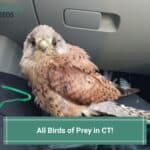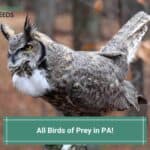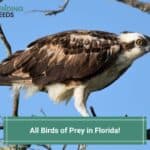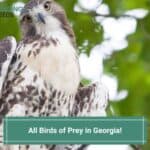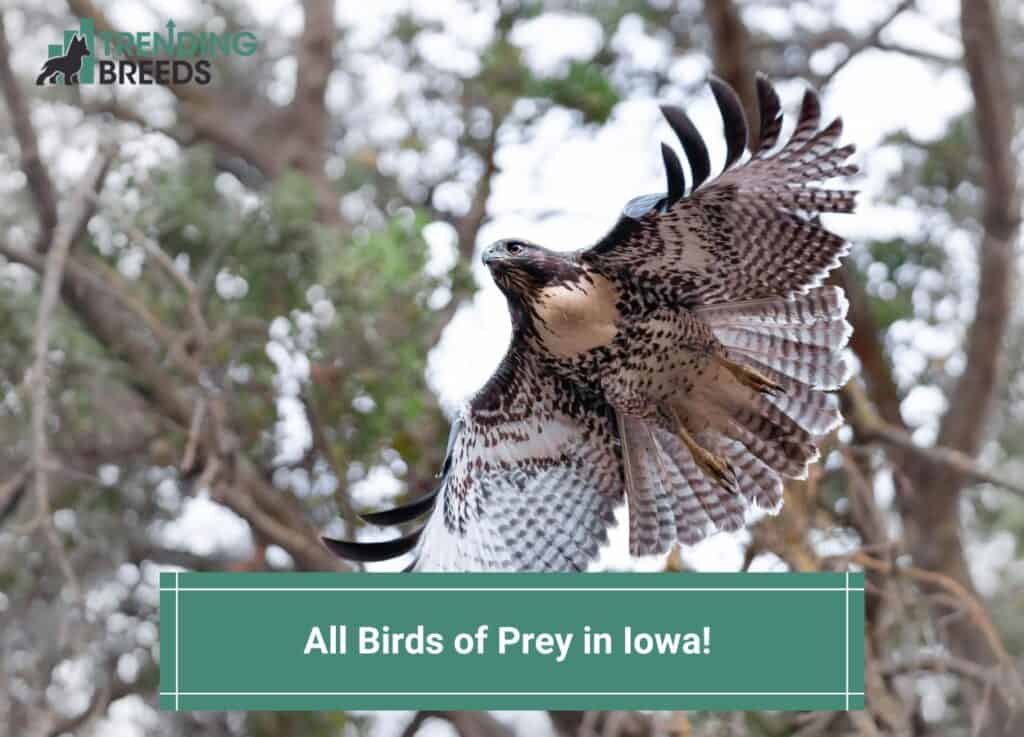
Are you searching for an article that will help you identify birds of prey in Iowa? You’ve come to the right place!
From Mississippi Kites hovering over open woodlands and Short-Eared Owls hanging around wetlands and coastal marshes, Iowa has been blessed with a diverse and mesmerizing bird life.
A total of 35 birds of prey are spotted in Iowa throughout the year.
These include ospreys, kites, eagles, and vultures, among others.
Iowa’s natural landscape with wetlands, forests, and prairies also provides ideal habitats for many raptors to migrate to and spend some time in the state.
In this article, you’ll find a detailed list of 13 birds of prey found in Iowa, their features, habitats, and other related information that may help you spot the common raptors in Iowa!
Before you scroll further down this guide, check out these other animal-related articles: Top Cavapoo Breeders in Iowa and Best Vizsla Breeders in Iowa.
Table of Contents
1. Osprey
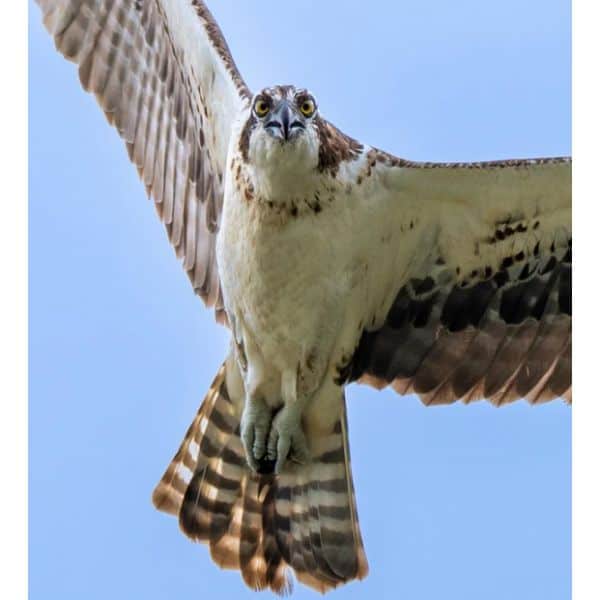
Osprey Characteristics:
- Scientific Name: Pandion haliaetus
- Length: 21.3-22.8 in (54-58 cm)
- Weight: 49.4-70.5 oz (1400-2000 g)
- Wingspan: 59.1-70.9 in (150-180 cm)
Ospreys are spotted in Iowa during the breeding season. They arrive in the state in March and migrate to colder areas around November.
The Osprey is a large bird with long wings stretching up to approximately 25 inches.
The bird is dark brown from the upper parts and white from below. It has little streaks and specs on its chest with pale white legs and feet.
Moreover, its tail is gray-brown with white-colored bars on them.
An Osprey’s head is one feature that distinguishes it from other birds. Its head is white and includes a mask, usually dark along the eyes.
The Osprey also has a large beak that is hooked and sharp.
An Osprey’s favorite food is fish, which is almost entirely what this bird hunts and consumes.
The type of fish an Osprey may hunt for varies by region.
However, flounder, smelt, bullhead, and sucker are the most common. Aside from fish, the bird may hunt for small mammals such as reptiles if fish are not available.
Known for its unique hunting style, an Osprey, after locating a fish after winging its body over a water body, will hover for a few seconds, flap its wings a few times, and finally, plunge straight into the water for its meal.
Even the Osprey’s favorite habitat revolves around its food – an Osprey can usually be found in shallow water with ample fish.
However, apart from waterbodies, you can also spot an Osprey hanging around poles and other tall manmade structures.
2. White-Tailed Kite
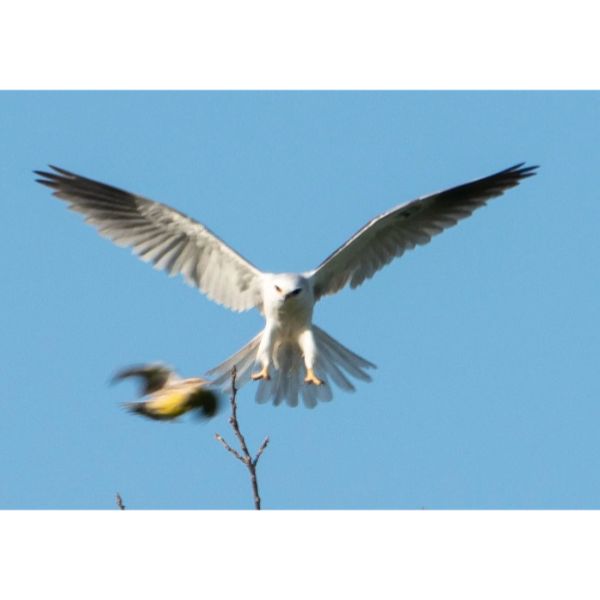
White-tailed Kite Characteristics:
- Scientific Name: Elanus leucurus
- Length: 12.6-15.0 in (32-38 cm)
- Weight: 10.6-12.7 oz (300-360 g)
- Wingspan: 39.0-43.3 in (99-110 cm)
Although white-tailed kites are a rare species in Iowa, this raptor has been spotted in the state now and then.
The last white-tailed kite was spotted in Iowa in 2019.
The White-tailed kite is a small to medium-sized bird of prey with a mostly pure white body.
The bird has a white head, legs, and belly with gray wings and back, black wingtips, and shoulders. Moreover, it has red eyes and a hooked black bill.
The White-tailed typically feeds on small mammals such as rodents and mice. However, it’s also fond of eating lizards, insects, and birds.
The White-tailed Kite hunts for its food by hovering rather than perching.
It hovers up to 70-80 feet off the ground and over its prey before dropping down straight to attack its meal using its powerful talons.
The white-tailed kite is found in open woodlands, marshes, savannas, grasslands, and various other open habitats.
3. Swallow-Tailed Kite
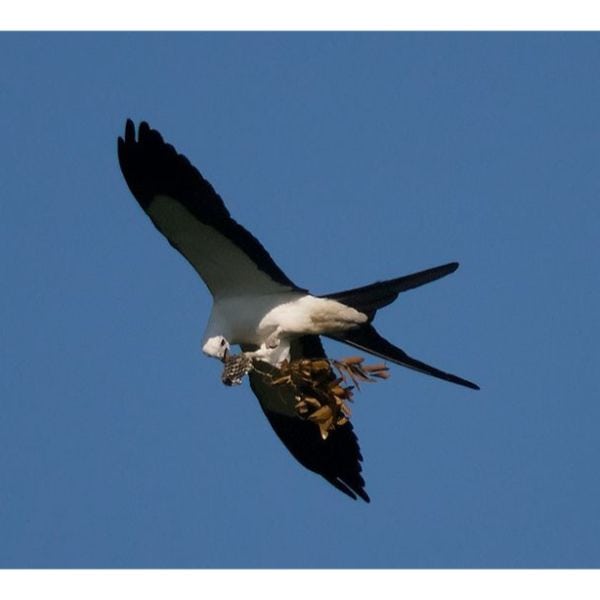
Swallowed-tailed Kite Characteristics:
- Scientific Name: Elanoides forficatus
- Length: 19.7-25.2 in (50-64 cm)
- Weight: 13.1-21.2 oz (370-600 g)
- Wingspan: 48.0 in (122 cm)
Last spotted in Earlham in 2021, the Swallow-tailed kite is another rare species in Iowa.
Known for its beauty, the Swallow-tailed kite is distinguished by the black-and-white contrast in its coloring.
It has a pure white head and underparts, whereas its back, wings, and tail are colored a matte bright. However, the underside of its wings is half black and half white.
The Swallow-tailed kite feeds mainly on big insects, like dragonflies, beetles, and grasshoppers.
But they can also eat small animals like snakes, frogs, and bats, especially when it comes to their nestlings. The Swallow-tailed kite is most likely to feed its nestling small animals.
They’re usually seen hunting for their meals in open country. It attacks most of its prey by plumbing low over trees and picking its favorite food by picking them up from leaves or twigs.
It may even take out small birds from their nests to feed on them.
Its habitat includes tall trees in wetland forests for nesting and open country, swamps, and floodplain forests, and it can find its prey in abundance elsewhere.
4. Mississippi Kite
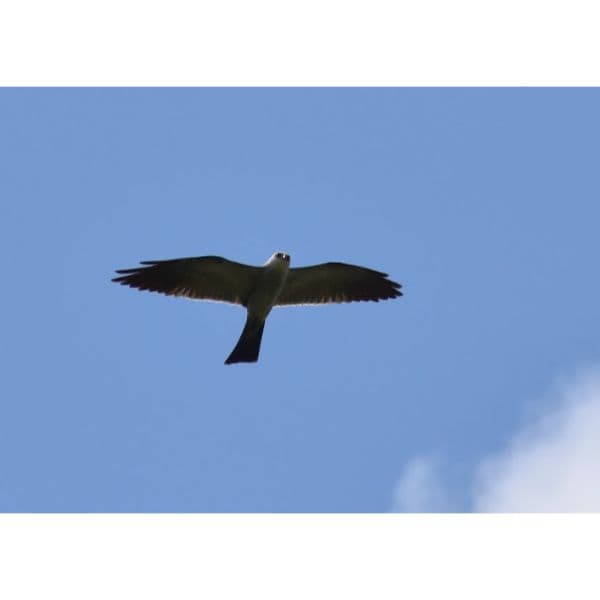
Mississippi Kite Characteristics:
- Scientific Name: Ictinia mississippiensis
- Length: 13.4-14.6 in (34-37 cm)
- Weight: 7.6-9.5 oz (216-269 g)
- Wingspan: 3 ft (91cm)
The Mississippi Kite is usually spotted in Iowa during the breeding season, May to September. It is a gray bird with dark gray tail feathers, light gray heads, and inner wings.
A relatively small bird (12-15) inches, it has pointed wings with a small yet hooked bill.
Its legs are colored yellow to red, and the kite has pure red eyes. It’s known to be graceful and highly skilled in flight.
The Mississippi Kite prefers to consume large insects, including grasshoppers, dragonflies, katydids, etc.
Aside from insects, it can also feed on ravens, raccoons, and Great-horned Owls. When the kite has an appetite for insects, it’s likely to catch them during flight.
With its diverse hunting styles, it can catch its prey while soaring up or perching and chasing after its prey.
Since the bird has powerful wings and can fly quickly, chasing after its meals is no biggie. It uses its sharp talons to grab its prey.
Its habitats include riparian forests, woodlands, prairies, and wooded neighborhoods, mainly in the suburbs.
5. Crested Caracara
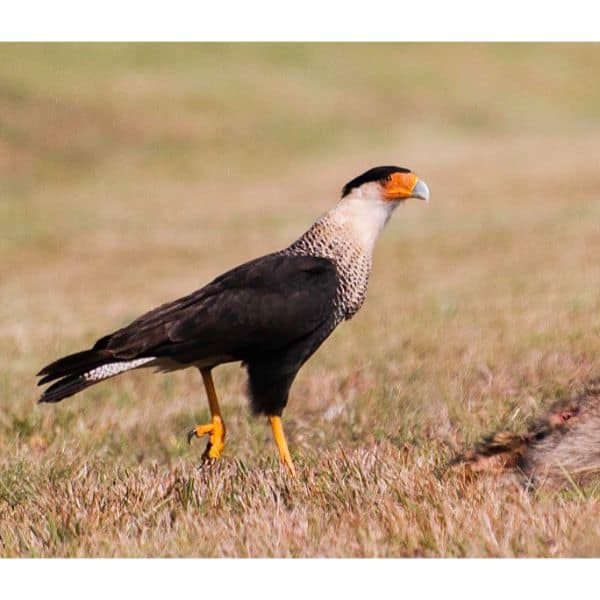
Crested Caracara Characteristics:
- Scientific Name: Caracara plancus
- Length: 19.3-22.8 in (49-58 cm)
- Weight: 37.0-45.9 oz (1050-1300 g)
- Wingspan: 48.0-49.2 in (122-125 cm)
Although the Crested Caracara is a rare species in Iowa, it has occasionally been spotted around Storm Lake.
Usually distinguished from its patch of feathers on the crown of its head, the bird’s body is primarily colored dark brown.
Its belly, cap, thighs, wings, and top of the tail are colored a matte shade of brown, with its nape and throat a mix of white and buff.
You can also identify the Crested Caracara by its reddish-brown beak.
Their diverse diet includes rabbits, squirrels, birds, eggs, snakes, alligators, and fish.
Therefore, it’s safe to assume that this bird will eat just about anything it comes across.
If you’re lucky enough to observe this bird hunting for its meal, you will likely see it alongside roads, searching for its prey on its feet, often hopping.
And boom! Whatever the Crested Caracara catches, it will consume!
They’re usually spotted near open landscapes like agricultural lands and prairies.
6. Prairie Falcon
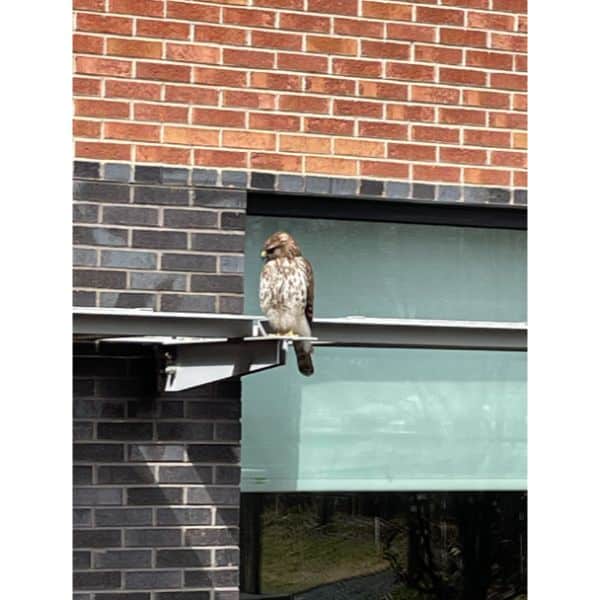
Prairie Falcon Characteristics:
- Scientific Name: Falco Mexicanus
- Length: 14.6-18.5 in (37-47 cm)
- Weight: 14.8-38.8 oz (420-1100 g)
- Wingspan: 35.4-44.5 in (90-113 cm)
Occasionally spotted in Iowa, this medium-sized bird of prey weighs approximately similar to a crow and has sandy-shaded plumage.
Its back and wings are brown with a pale head and patterned underside. Its thighs are reddish-brown, and its legs and cere are yellow.
This cunning falcon usually hunts other birds of prey, such as burrowing owls.
It also feeds on small mammals such as chipmunks, squirrels, ground squirrels, and rabbits. It also hunts for birds such as teals, coots, and, occasionally, some reptiles.
When it comes to catching its prey, the Prairie Falcon flies uniquely; you will spot it flying in speed yet flying low over its target.
However, it can employ different strategies to hunt, usually based on the kind of prey they’re perusing.
It can aim for its prey by sighting it from a perch and engaging in a tail chase.
It is also fond of taking its prey by surprise. You will likely spot this prey in arid and semi-arid plains or on rock cliffs alongside rivers.
7. Merlin
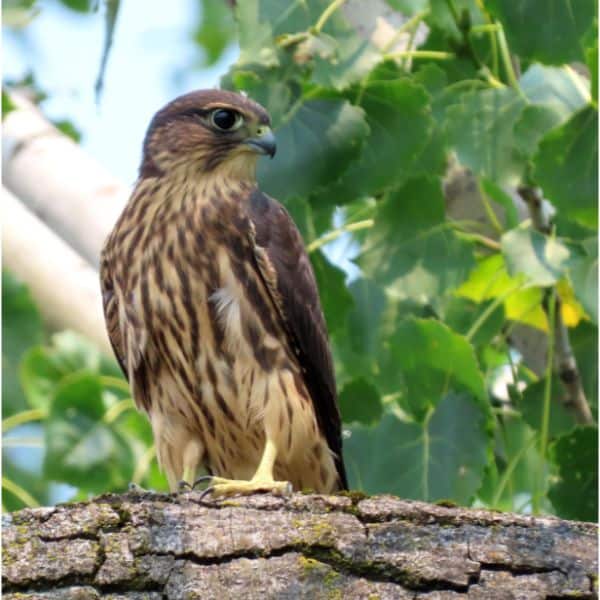
Merlin Characteristics:
- Scientific Name: Falco columbarius
- Length: 9.4-11.8 in (24-30 cm)
- Weight: 5.6-8.5 oz (160-240 g)
- Wingspan: 20.9-26.8 in (53-68 cm)
You’re likely to spot Merlins in Iowa during the winter. However, they’re also known to migrate to the state from September to October.
A small species of falcon, the Merlin can be distinguished from other falcons due to its small size, unique gray-blue back and tail, and light cream-colored chest.
Moreover, the bird’s front is streaked black with a rufous color.
When it comes to Merlin’s diet, he is usually fond of consuming a variety of tiny birds such as sparrows, larks, pipits, and quails.
However, insects, particularly dragonflies and moths, also comprise a significant portion of their diets. Occasionally, it can also feed on reptiles when other options are scarce.
The Merlin utilizes its skills of speed to peruse prey. You will often catch this gorgeous bird attacking its prey by flying low yet quickly over the ground.
Moreover, it can also be found looking for food in trees and shrubs.
Merlins usually hunt in grasslands. However, they will likely use small rocky ridges or conifer plantations for nesting.
8. Peregrine Falcon
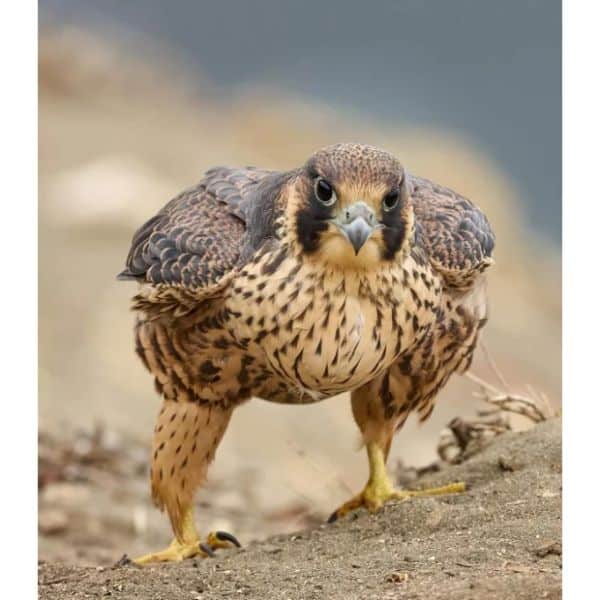
Peregrine Falcon Characteristics:
- Scientific Name: Falco peregrinus
- Length: 13-23 in (34-58cm)
- Weight: 12 – 14 oz (330 – 400 g)
- Wingspan: 33.1 – 44.9 in (79-114 cm)
Next up on our list of birds of prey in Iowa is the Peregrine Falcon, a raptor found in Iowa from April to May and August to September.
Known as the most powerful falcon species, the Peregrine Falcon is a large raptor distinguished by its broad, long, and pointed wings but relatively short rectrices and tail.
The falcon is blue-grey from the top, with the top of its head colored black. Moreover, its chest is patterned with a fine barring.
The Peregrine Falcon has an interesting diet. It consists of large birds, such as Sandhill cranes, and small birds, such as hummingbirds.
However, it can also happily consume pigeons, ducks, songbirds, and gulls.
Peregrine Falcons hunt for their prey during dawn and dusk. Peregrines are also known to attack birds they want to prey on when the bird is in flight.
They swoop and dive down at a fast speed to catch their prey. It usually kills its prey by clenching its foot, killing it immediately.
The Peregrine Falcons have diverse habitats, including cities, forests, coastlines, and valleys.
9. Black Vulture
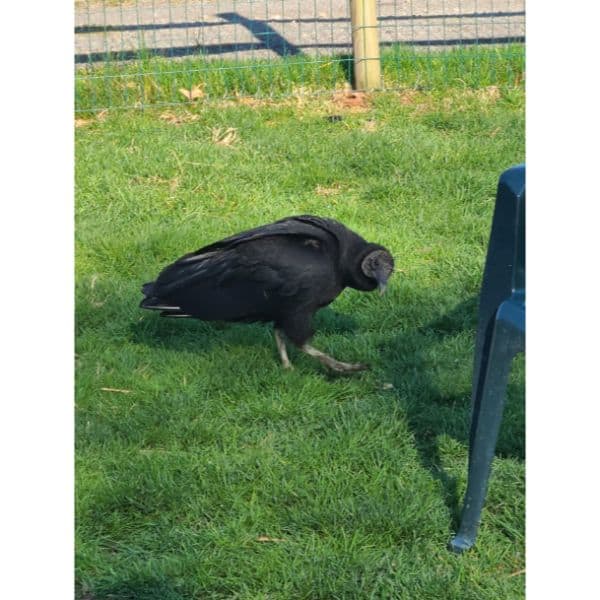
Black Vulture Characteristics:
- Scientific Name: Coragyps atratus
- Length: 23.6-26.8 in (60-68 cm)
- Weight: 56.4-77.6 oz (1600-2200 g)
- Wingspan: 53.9-59.1 in (137-150 cm)
Although the Black Vulture is rarely spotted in Iowa, it was last spotted in 2019 near Ada Hayden Heritage Park. However, it is generally considered one of the most widespread birds in America.
The Black Vulture is easily identifiable, thanks to its sooty plumage and black head.
The bird has broad, wide wings with a square-shaped, short tail. Its legs are long and gray.
The Black Vulture is known to feed on the carcasses of dead animals, irrespective of size. However, it is also fond of eating eggs from other birds’ possessions and other animals such as lizards, turtles, and coyotes.
The Black Vulture can eat rotten, fresh fruits and other plant-based foods.The Black Vulture is known to locate the carcass it eats by soaring high in the sky.
However, it’s also known to fly to keep an eye on Turkey Vultures who have an excellent sense of smell, and the Black Vulture then follows the Turkey Vulture to catch its meal.
When by itself, it looks for its prey solely using its sight. Mostly found in low elevations, the Black Vulture also inhibits open areas and forested areas.
10. Turkey Vulture
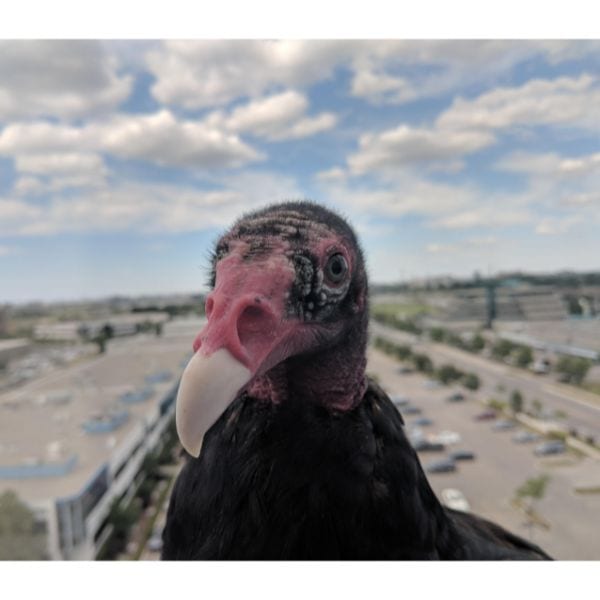
Turkey Vulture Characteristics:
- Scientific Name: Cathartes aura
- Length: 25.2-31.9 in (64-81 cm)
- Weight: 70.5 oz (2000 g)
- Wingspan: 66.9-70.1 in (170-178 cm)
Turkey Vultures are found in Iowa from March to October. However, some can also be found in the state all year round.
The Turkey Vulture is a large, dark-colored bird. It can be identified by the silver linings trailing along its wings.
It has a bare red head and a long tail. Another distinguishable feature of the Turkey Vulture is its shallow V-shaped wings that wobble from side to side in flight.
Turkey’s Vulture usually consumes carrions, primarily belonging to mammals.
However, they can also eat carcasses of reptiles, invertebrates, and amphibians. It is also known to catch bird nestlings or sick birds.
The Turkey Vulture has an exceptional sense of smell, which is why it’s easy for it to identify carrions from miles away.
These raptors nest in rock crevices, thickets, mammal burrows, fallen trees, and hollow logs.
11. Ferruginous Hawk
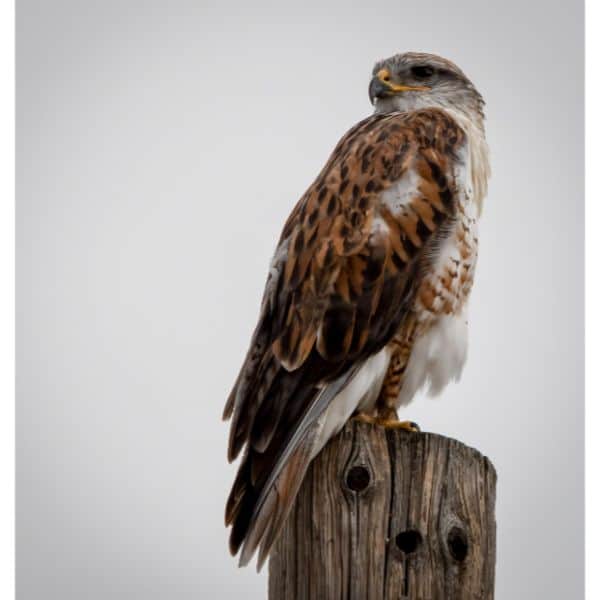
Ferruginous Hawk Characteristics:
- Scientific Name: Buteo regalis
- Length: 22.1-27.2 in (56-69 cm)
- Weight: 34.5-73.2 oz (977-2074 g)
- Wingspan: 52.4-55.9 in (133-142 cm)
Ferruginous Hawks are rarely found in Iowa, and the bird was last spotted in the state in 2021.
The Ferruginous Hawk is a large broad-bodied buteo. Some Ferruginous Hawks are light morphs, whereas some are dark morphs.
Although light morph is more common in adults, the adults are rufous from the upper part of their body with gray-blue feathers and a white-colored breast with barring on the sides.
Dark morphs Ferruginous Hawks, on the other hand, are brown overall with white undersides and a pale tail.
The Ferruginous Hawk usually eats small to medium-sized mammals.
These mammals include ground squirrels, mice, jackrabbits, and birds. However, it may also occasionally feed on reptiles such as snakes.
This bird is known to catch its prey in a sit-and-watch manner or through a low-searching flight where it swoops down on its prey from the top.
However, sometimes, it may even approach its target from the ground on foot.
The Ferruginous Hawk inhibits semi-arid and arid grasslands, lowlands, prairies, valleys, and plains.
12. Cooper’s Hawk
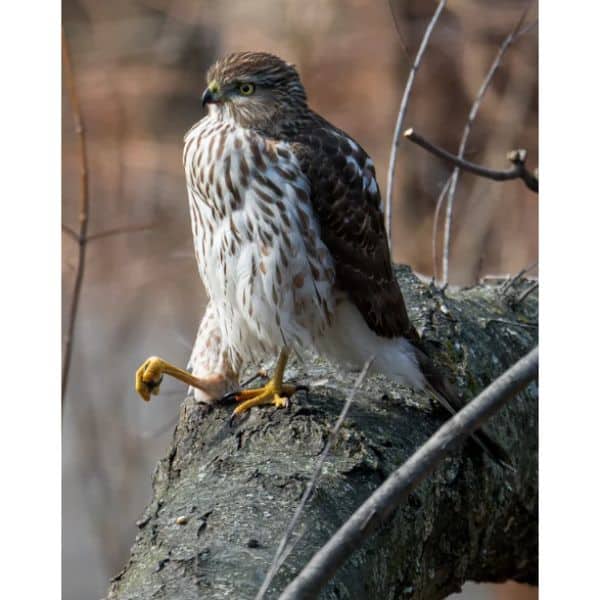
Cooper’s Hawk Characteristics:
- Scientific Name: Accipiter Cooperii
- Length: 14.6-17.7 in (37-45 cm)
- Weight: 7.8-24.0 oz (220-680 g)
- Wingspan: 24.4-35.4 in (62-90 cm)
Cooper’s Hawks are found in Iowa all year round.
The Cooper’s Hawk is a compact, medium-sized bird of prey with round wings and a long, rounded tail with black and gray barring.
Its back and wings are a grayish brown shade with rufous colored streaked pattern on its belly and breast. The bird’s head also often appears large from afar.
Its diet is primarily consisting of small mammals and birds. The bird it consumes is usually medium-sized, such as jays, flickers, and robins.
Small mammals such as chipmunks, ground squirrels, and bats are also central to the bird’s diet.
It hunts in a sneak-ish manner; it makes its way to its prey using dense cover and suddenly swoops towards it with a speedy flight, seizing it.
Being a forest species, Cooper’s Hawks are commonly found in deciduous and mixed forests, woodlots, open woodlands, and forested mountainous regions.
13. Bald Eagle
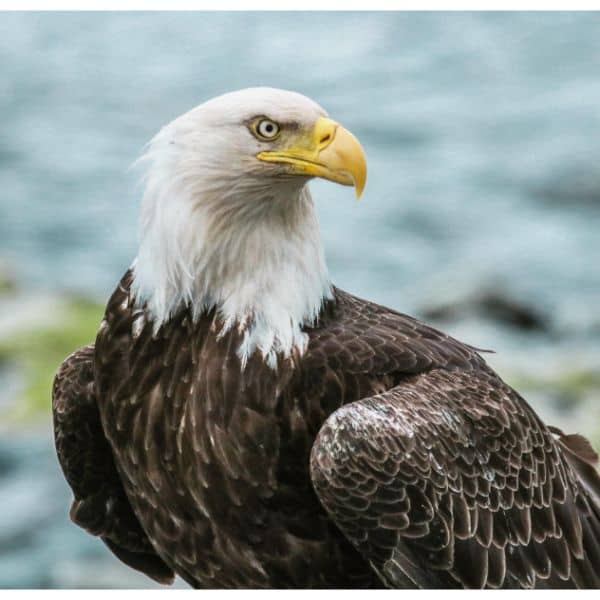
Bald Eagle Characteristics:
- Scientific Name: Haliaeetus leucocephalus
- Length: 27.9-37.8 in (71-96 cm)
- Weight: 105.8-222.2 oz (3000-6300 g)
- Wingspan: 80.3 in (204 cm)
The Bald Eagle is the last on our list of 13 birds of prey in Iowa. It is a year-round resident of the state.
However, its numbers increased significantly in the state from November to March.
The Bald Eagle is a reasonably large raptor, easily identified due to its white head.
However, the Bald Eagle is not bald; the name originates from an old meaning of bald, translating to white-headed.
The body of a Bald Eagle is chocolate-brown, with its legs and bill bright yellow. Moreover, the Bald Eagle has large, broad wings.
The Bald Eagle’s diet includes fish and birds. Mammals are a rare feed. However, sometimes they may consume rabbits, snakes, crabs, and amphibians.
Bald Eagles use their powerful talons to grab their prey. When searching for birds or mammals, they look for these animals from a perch before engaging in a chase.
However, when hunting for fish, they will either grab fish using their beaks or with their talons.
Bald eagles are commonly spotted along rivers, lakes, coasts, and reservoirs.
All Birds of Prey in Iowa
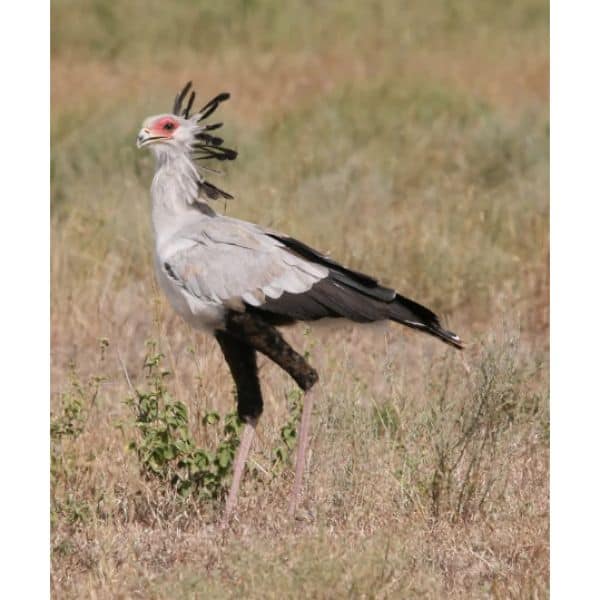
Iowa is home to a diverse and lively birdlife.
This active birdlife is a testament to nature’s beauty and a constant reminder of the importance of conversing with and safeguarding the wildlife of Iowa.
If you’re looking to go birdwatching in the Hawkeyes state, we recommend visiting the Great River Birding Trail, Saylorville Reservoir, Yellow River State Forest, or other nearby areas with open fields, grasslands, or meadows.
Here, you’ll spot the most birds of prey in Iowa.
If you find this guide, “All Birds of Prey in Iowa,” informative and helpful, you can check out these other bird-related articles from our team:
You can learn more about birds by watching “How To Tame a HAWK in Real Life | How to Man Your Hawk” down below:

